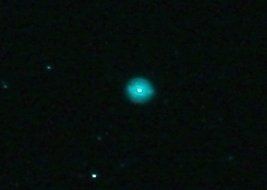DSO of the Month
: Caldwell 15
AKA: The Blinking Nebula; Blinking Planetary; NGC 6826
Position: 19 hrs 44 min 48.2 sec +50 degrees 31 min 30 sec
Due south at 23.08 (BST) on 15 August 2021
Caldwell 15 (The Blinking Nebula)
Image by Martin Gill, HAS. Used with permission.
After observing such exotic items as a quasar and a black hole, we are back in our usual territory of planetary nebulae for the next two months. This month we have the Blinking Nebula (or Blinking Planetary more accurately) in Cygnus. It is did not get its name because it was difficult to observe (although it is not the easiest of planetary nebulae to see), but because it displays a “blinking image” effect. The relatively bright star in the middle of the nebula overwhelms the fainter nebula. However if you look at the nebula with averted vision (point your eyes away from the star), you see the nebula and then when you look back at the star again it disappears. At least that is the theory, it does not work for everyone – does it work for you? This planetary nebula looks like a blue or blue-green spot (or “planet”) in a small telescope. To enhance your view of it, you may have some success with an OIII filter. In larger telescopes such as the Hubble Space Telescope, it has a bright triangular central region surrounded by an oval with two bright regions on each side of the centre called Fast Low-Ionization Emission Regions (FLIERS). It was discovered by William Herschel in 1793 but for many years it was just known as NGC 6826. The name Blinking Nebula appears to have been introduced by Patrick Moore around 1973 and the more precise alternative Blinking Planetary by Robert Burnham (who often drew on Moore’s writings) four or five years later.
Lying at a great distance of about 2,000 light years, Caldwell 15 sits on the north-eastern “wing” of Cygnus. To locate it, find the relative bright star (mag. 2.9) Delta Cygni and then go along the wing to the dimmer (mag. 3.8) Iota Cygni. Between the two stars (but much closer to Iota than Delta) and slightly off the wing (to the left) is another even dimmer star Theta Cygni (mag. 4.5). You should now see three stars in a crooked row in your finderscope, the right-hand one is Theta Cygni, the middle one is the double star 16 Cygni (mag. 6.25) and the one on the left is HD 186924 (mag. 7.0). This is the star at the centre of Caldwell 15 which is a little smaller than the full Moon and is about magnitude 9 so fairly dim.
ARCHIVE
